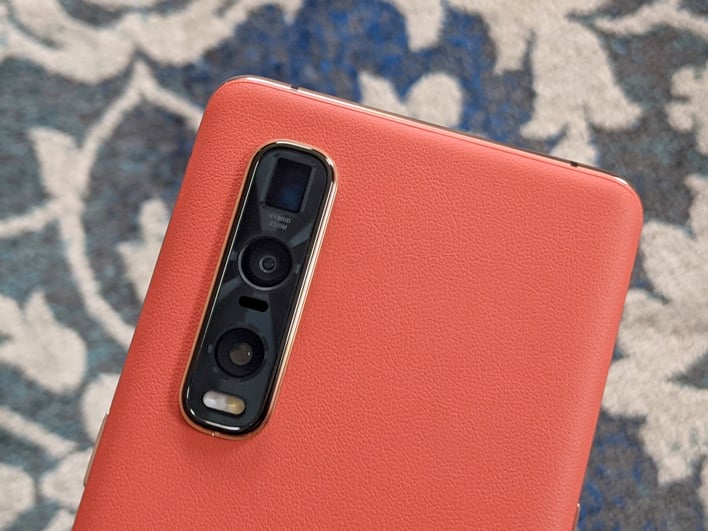Oppo Find X2 Pro Review: Powerful, Super-Premium, Pricey
Oppo Find X2 Pro Camera Performance And Image Samples
Here’s where things get interesting. The Find X2 Pro packs three rear cameras -- a 48MP f/1.7 1.12-micron main shooter with OIS, a 48MP f/2.2 0.8-micron 120-degree ultrawide (with AF for macro photography), and a 13MP f/3.0 1-micron 5x periscope telephoto with OIS. Are you drooling over the specs yet? This setup is similar to Huawei’s P40 Pro, but using RGGB (vs. RYYB) sensors for the main and telephoto cameras. Also, based on the specs, the Oppo Find X2 Pro clearly shares its main and ultrawide shooters with the OnePlus 8 Pro -- not a bad thing.
The IMX 586 was the 48MP main sensor of choice for many handsets in 2019 -- from premium mid-range models like Oppo’s Reno2 series, to affordable flagships like the entire OnePlus 7 line. So it’s pretty wild to see it getting repurposed for ultrawide duty on the Find X2 Pro (and OnePlus 8 Pro). On the selfie front, we’ve got a 32MP f/2.4 0.8-micron shooter without AF. Unfortunately, this camera doesn’t appear to support 4-to-1 pixel binning (for an 8MP output), to compensate for the small aperture and pixel size, which is a missed opportunity.
The resulting photos and videos speak for themselves. We really like the Find X2 Pro’s camera. It doesn’t over-sharpen pictures like Samsung, and doesn’t boost colors like OnePlus. This makes for very neutral but pleasant images, with a lot of editing headroom. What’s most impressive, though, is how consistent the color science is between the three shooters. It’s not something we’re used to seeing on most Android devices (we’re looking at you, Huawei and Leica), but it’s something Apple nails on the latest iPhones. Well done, Oppo!
But let’s talk about Sony’s massive new 1/1.43in IMX 689 (main camera), and Sony’s excellent 1/2.0in IMX 586 (ultrawide). First, these 48MP Quad-Bayer sensors can output 12MP by “binning” (combining) 4 pixels into one for an effective pixel size of 2.24 and 1.6-microns, respectively. In simple terms, this trick significantly improves low-light imaging performance. Second, the IMX 689 is the first sensor on the market to feature all-pixel omnidirectional PDAF. Without getting too technical, this means faster and better AF, even in low light.
The IMX 586 was the 48MP main sensor of choice for many handsets in 2019 -- from premium mid-range models like Oppo’s Reno2 series, to affordable flagships like the entire OnePlus 7 line. So it’s pretty wild to see it getting repurposed for ultrawide duty on the Find X2 Pro (and OnePlus 8 Pro). On the selfie front, we’ve got a 32MP f/2.4 0.8-micron shooter without AF. Unfortunately, this camera doesn’t appear to support 4-to-1 pixel binning (for an 8MP output), to compensate for the small aperture and pixel size, which is a missed opportunity.
As for video recording, the Find X2 Pro captures up to 4K 60fps stabilized using the main shooter, and up to 4K 30fps stabilized with HDR enabled. There’s also an Ultra Steady mode, and an Ultra Steady Pro mode which taps into the ultrawide lens (both up to 1080p 60fps). Slow motion is supported at 720p 480fps and 1080p 240fps. The telephoto isn’t available for video recording, but the main sensor handles digital zoom up to 5X. Selfie videos cap out at 1080p 30fps. Other than lacking 8K capture, this is a pretty complete setup.
Exposure and white balance are spot on, and the dynamic range is excellent. But it’s in low light that the Find X2 Pro really shines, especially with the main camera -- just look at our sample photos. We’re less enamored with that front shooter. The resulting selfies aren’t terrible, but aren’t Pixel or iPhone worthy -- especially in portrait mode. It’s a bit odd considering Oppo’s long-time expertise with front cameras. On the plus side, there’s a night mode for selfies, and it works surprisingly well in low light.
Next up: audio, performance, and battery life...
















